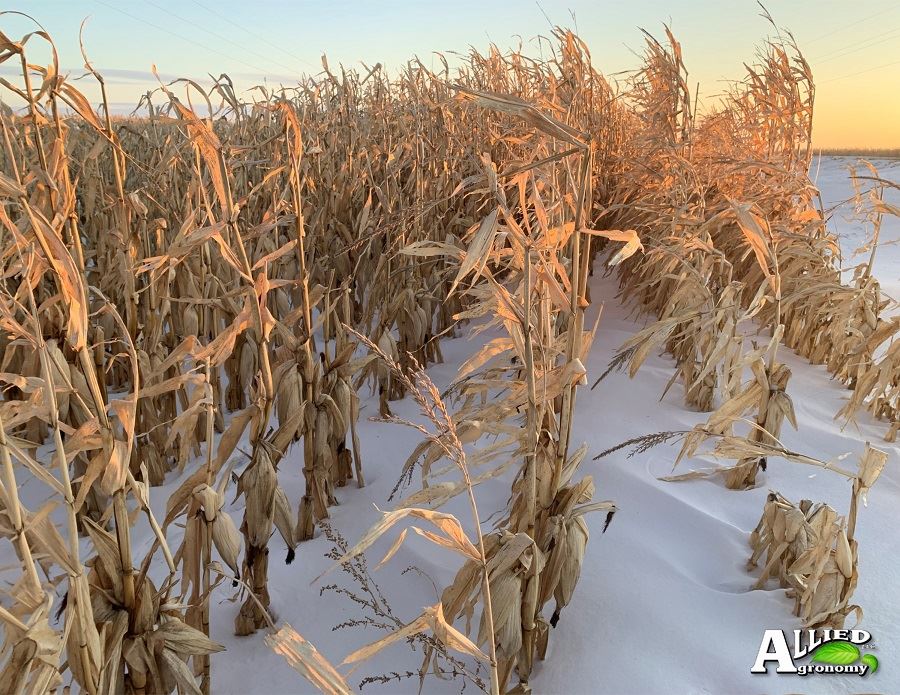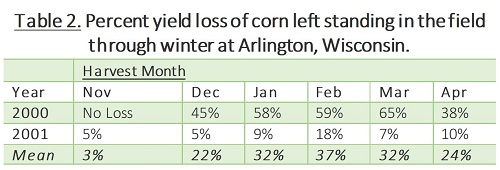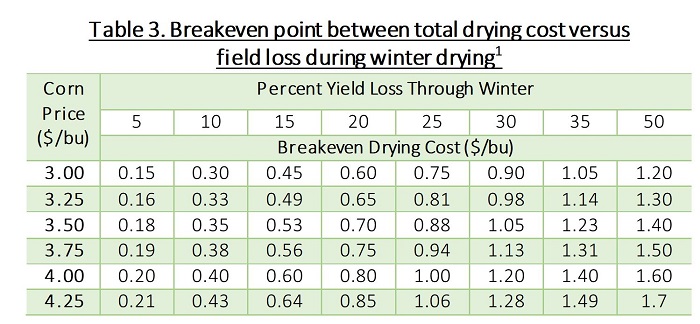Overwintering Corn Considerations
Jan 02, 2020

We can all agree 2019 was one of the tougher growing years we have faced. Cold and wet conditions have been ongoing from last spring throughout this fall, and now we are facing winter with approximately 57% of the corn left standing in North Dakota fields. Traveling throughout Allied Agronomy’s territory this is very evident with many corn fields still standing from north to south. The question now remains, “what are the risks of leaving my crop out in the field until next spring, and what are some considerations I must think of while harvesting this winter?”
With late, wet planting last spring there has been many fields with significant disease pressure this year, which has resulted in stalk integrity being compromised. With poor stalk quality from 2019, in combination with the heavy snow and wind that is predicted this winter, we could have some significant lodging resulting in yield losses. Other causes for loss could be dependent on plant populations, ear drop, ear size, overall grain quality, wildlife damage and actual environmental conditions that play out through this winter.
Research conducted at the University of Wisconsin studied corn loss during the winter (Table 2)1. The research showed in 2000, a year with heavy snow cover, losses ranged from 38%-65%. Significantly lower in 2001 which had very little snow cover, yield losses ranged from 5-18%. “The spread of what can happen is really wide, and the bottom line is the longer the corn is in the field, the more risk you take on,” Lauer said.

Some farmers will still have a window to harvest their corn during the winter. The cost of drying wet corn should be compared to the cost of leaving the corn in the field throughout the winter’s breakeven cost.
Table 3 provides a total drying charge compared to a 5% to 40% winter yield loss at grain prices ranging from $3.00 to $4.25 per bushel.1

According to Ken Hellevang NDSU Extension Agricultural Engineer “Leaving the corn unharvested may not be cost effective. Estimate propane drying costs per point of moisture removed per bushel by multiplying the propane cost per gallon by 0.02. For propane at $1.50 per gallon, the propane cost would be $0.03 per bushel per point of moisture removed. If corn is dried 10 percentage points, that is a cost of $0.30 per bushel. If the corn price is $3 per bushel, the $0.30 drying energy cost is equivalent to a 10% ($0.30/bushel / $3 = 0.10 = 10%) field loss during the winter.”
Other factors to consider for winter harvest
If a farmer does decide to leave their corn crop out in the field this winter they need to have it harvested by June 10th in order to qualify for preventive plant. But letting corn stand in the field will allow it to gain test weight by naturally air drying. Hellevang also states that corn in North Dakota that remains in the field could dry from 25-30% moisture in November to about 17-20% when harvested in February and early march.
Once you’ve weighed the pros and cons of the unexpected variables, if the value of the corn lost over winter is greater than anticipated drying costs of wet-harvested corn this fall, then it makes sense to go ahead and get it out of the field. If drying and storage will cost more than expected losses, then waiting to harvest until spring is a good consideration. Your bottom line is the most important.
SOURCES:
1Schneider, N. and Lauer, J. 2009. Weigh risk of leaving corn stand through winter. University of Wisconsin. http://corn.agronomy.wisc.edu/
NDSU Agriculture Communication – November 27th, 2019
Overwintering corn until spring has a risk of yield loss.
With late, wet planting last spring there has been many fields with significant disease pressure this year, which has resulted in stalk integrity being compromised. With poor stalk quality from 2019, in combination with the heavy snow and wind that is predicted this winter, we could have some significant lodging resulting in yield losses. Other causes for loss could be dependent on plant populations, ear drop, ear size, overall grain quality, wildlife damage and actual environmental conditions that play out through this winter.
Research conducted at the University of Wisconsin studied corn loss during the winter (Table 2)1. The research showed in 2000, a year with heavy snow cover, losses ranged from 38%-65%. Significantly lower in 2001 which had very little snow cover, yield losses ranged from 5-18%. “The spread of what can happen is really wide, and the bottom line is the longer the corn is in the field, the more risk you take on,” Lauer said.

Winter harvest considerations
Some farmers will still have a window to harvest their corn during the winter. The cost of drying wet corn should be compared to the cost of leaving the corn in the field throughout the winter’s breakeven cost.
Table 3 provides a total drying charge compared to a 5% to 40% winter yield loss at grain prices ranging from $3.00 to $4.25 per bushel.1

According to Ken Hellevang NDSU Extension Agricultural Engineer “Leaving the corn unharvested may not be cost effective. Estimate propane drying costs per point of moisture removed per bushel by multiplying the propane cost per gallon by 0.02. For propane at $1.50 per gallon, the propane cost would be $0.03 per bushel per point of moisture removed. If corn is dried 10 percentage points, that is a cost of $0.30 per bushel. If the corn price is $3 per bushel, the $0.30 drying energy cost is equivalent to a 10% ($0.30/bushel / $3 = 0.10 = 10%) field loss during the winter.”
Other factors to consider for winter harvest
- Can the field support harvesting without causing major compaction or ruts?
- Will equipment be damaged harvesting through snow and wet fields?
- What is your stalk/root strength? Some fields may need to be prioritized if you are able to get out into the field
- Ear molds and sprouting in the spring can also occur if letting corn stand.
- Drying and storage situations
Waiting Until Spring to Harvest
If a farmer does decide to leave their corn crop out in the field this winter they need to have it harvested by June 10th in order to qualify for preventive plant. But letting corn stand in the field will allow it to gain test weight by naturally air drying. Hellevang also states that corn in North Dakota that remains in the field could dry from 25-30% moisture in November to about 17-20% when harvested in February and early march.
Make the Best Decision for Your Farm
Once you’ve weighed the pros and cons of the unexpected variables, if the value of the corn lost over winter is greater than anticipated drying costs of wet-harvested corn this fall, then it makes sense to go ahead and get it out of the field. If drying and storage will cost more than expected losses, then waiting to harvest until spring is a good consideration. Your bottom line is the most important.
SOURCES:
1Schneider, N. and Lauer, J. 2009. Weigh risk of leaving corn stand through winter. University of Wisconsin. http://corn.agronomy.wisc.edu/
NDSU Agriculture Communication – November 27th, 2019